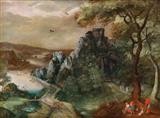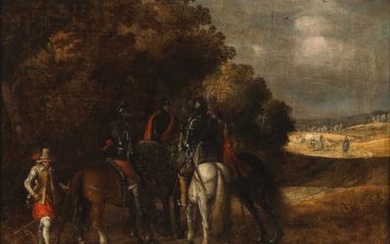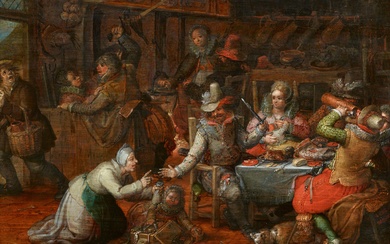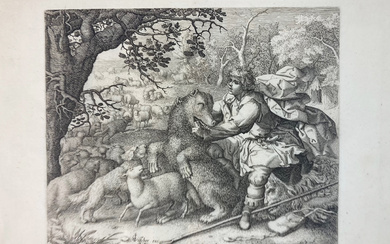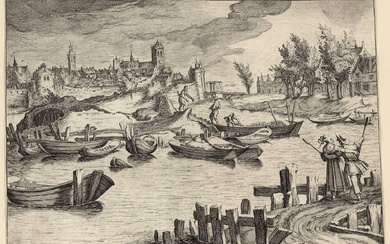David Vinckboons
(Mechelen 1576–1633 Amsterdam)
An extensive mountainous river landscape with a castle on a hill,
oil on canvas, 81.5 x 109 cm, framed
We are grateful to Klaus Ertz for confirming the attribution of the present painting, which is accompanied by a certificate.
The impressive panorama is part of a group of more sombre landscapes, close to Jan Brueghel the Elder and also inspired by Pieter Brueghel the Younger (c.f. Pieter Brueghel the Elder, St. Jerome in the desert, engraving, K. Ertz and C. Nitze-Ertz: David Vinckboons, Lingen 2016, p. 48, fig. 62, or Ertz, loc. cit., cat. no. 9, pp. 306, 307). The present painting with its attractive motif of a castle dominating a valley landscape also recalls the work of Valckenborgh.
As Goossens notes (K. Goossens, Nog meer over David Vinckboons, in: Jaarboek van het Koninklijk Museum te Antwerpen, 1966, p. 10), the basic composition of this work, with a bridge spanning a limpid pool in the foreground and a winding valley receding into the distance, was of great importance to Vinckboons. He experimented with this setting in a number of paintings, always varying the subject and the details of the staffage, which he modified to suit both specific and general narratives, including the Landscape with Christ healing the servant of the Centurion of Capernaum (Bayerische Staatsgemäldesammlungen, Munich, Ertz cat. no. 1) Landscape with a Country Wedding (Brunswick, Herzog Anton Ulrich-Museum, Ertz cat. no. 3) and Landscape with elegant figures (Loan to the Situation Kunst foundation, Bochum, Ertz cat. no. 9) Vinckboons spent almost his entire life in Amsterdam. His style is unmistakably Flemish, and he belongs to that extraordinary generation of Netherlandish artists who, compelled by religious persecution to move either north to the Protestant stronghold or south to the Catholic one, effected one of the most significant cross-pollinations of style and taste in the history of art. His debt to Gillis van Coninxloo III, whom van Mander described as ‘the best landscape painter of his time’, is particularly strong in this painting. Coninxloo, a pupil of Pieter Coecke van Aelst and a close relative of the Brueghel family, may have been Vinckboons’s teacher and may have helped familiarise the latter with the kermis pictures by the Brueghels and Marten van Cleve. The uncannily fine detailing in the present work harks back to the miniaturism of early Flemish masters such as Herri met de Bles. On the other hand, the painterly evocation of the misty distance anticipates the slightly later works of Hercules Seghers, whose importance to Dutch landscape painting has been widely discussed.
View it on
Estimate
Time, Location
Auction House
(Mechelen 1576–1633 Amsterdam)
An extensive mountainous river landscape with a castle on a hill,
oil on canvas, 81.5 x 109 cm, framed
We are grateful to Klaus Ertz for confirming the attribution of the present painting, which is accompanied by a certificate.
The impressive panorama is part of a group of more sombre landscapes, close to Jan Brueghel the Elder and also inspired by Pieter Brueghel the Younger (c.f. Pieter Brueghel the Elder, St. Jerome in the desert, engraving, K. Ertz and C. Nitze-Ertz: David Vinckboons, Lingen 2016, p. 48, fig. 62, or Ertz, loc. cit., cat. no. 9, pp. 306, 307). The present painting with its attractive motif of a castle dominating a valley landscape also recalls the work of Valckenborgh.
As Goossens notes (K. Goossens, Nog meer over David Vinckboons, in: Jaarboek van het Koninklijk Museum te Antwerpen, 1966, p. 10), the basic composition of this work, with a bridge spanning a limpid pool in the foreground and a winding valley receding into the distance, was of great importance to Vinckboons. He experimented with this setting in a number of paintings, always varying the subject and the details of the staffage, which he modified to suit both specific and general narratives, including the Landscape with Christ healing the servant of the Centurion of Capernaum (Bayerische Staatsgemäldesammlungen, Munich, Ertz cat. no. 1) Landscape with a Country Wedding (Brunswick, Herzog Anton Ulrich-Museum, Ertz cat. no. 3) and Landscape with elegant figures (Loan to the Situation Kunst foundation, Bochum, Ertz cat. no. 9) Vinckboons spent almost his entire life in Amsterdam. His style is unmistakably Flemish, and he belongs to that extraordinary generation of Netherlandish artists who, compelled by religious persecution to move either north to the Protestant stronghold or south to the Catholic one, effected one of the most significant cross-pollinations of style and taste in the history of art. His debt to Gillis van Coninxloo III, whom van Mander described as ‘the best landscape painter of his time’, is particularly strong in this painting. Coninxloo, a pupil of Pieter Coecke van Aelst and a close relative of the Brueghel family, may have been Vinckboons’s teacher and may have helped familiarise the latter with the kermis pictures by the Brueghels and Marten van Cleve. The uncannily fine detailing in the present work harks back to the miniaturism of early Flemish masters such as Herri met de Bles. On the other hand, the painterly evocation of the misty distance anticipates the slightly later works of Hercules Seghers, whose importance to Dutch landscape painting has been widely discussed.
